Published
on 23
Jun 2009
|
All rights reserved.
|
|
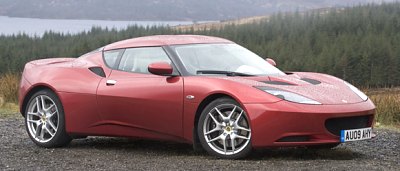
|
After 13 years, Lotus has finally
introduced an all-new model...
|
As
a reflection of the condition of its automotive industry, British Motor
Show has been declining in the past decade. Fewer car makers join the
event, and even fewer choose it to make world debuts. Visitor number is
declining and the atmosphere is going down. However, last summer’s
London Motor Show saw a rare excitement on the stage of Lotus. No music
or dancing, but immersed in applause and flashlight the new Lotus Evora
was unveiled to the world for the first time. Yes, this is Lotus' first
all-new model in 13 years - the last time we saw a similar scene was
the debut of Elise.
Developed under the name “Project Eagle” in a record 27 months, the
Evora will sit in the middle of the company’s 3-tier model range, which
will be completed when the new Esprit arrives in 2011. Its production
volume is expected to be 2,000 units a year, about as many as Ferrari
F430, but only a fraction of Porsche 911 or Cayman. However, that will
be enough to double the current capacity of Hethel. Most important, its
higher profit margin should enable Lotus to fund the development of
Esprit and other models in the future. Boss Mike Kimberley will be
grateful that he no longer needs to beg Proton for more financial
support.
Like Elise and Esprit, Evora follows the optimal mechanical layout
preferred by Colin Chapman, i.e. a low-slung mid-engined sports car.
Unlike them, however, it is designed to be a user-friendly 2+2, like
Porsche 911. This format has been disappeared from the world since
Ferrari Mondial retired in 1993. As you have predicted, its rear seats
are not suitable to normal adults, but it will have little difficulty
to take children up to 5 feet tall. This make it more practical than
its rivals at Porsche. Sure, the flat and upright bench seat has little
comfort to speak of, but at least it doubles as an additional luggage
space, which is especially useful as the boot behind the engine
compartment can swallow only 160 liters of things. If you don’t have
children, you can ask Lotus to ditch the rear seat for a luggage bench.
That will also save some 15 kg.
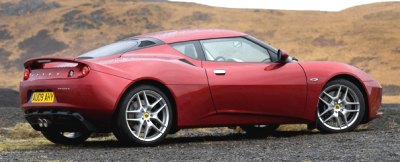
|
The mid-engined 2+2 format has been
disappeared from the world since Ferrari Mondial retired in 1993.
|
For
a 2+2, the Evora is surprisingly compact. It measures only 4.34 meters
long, 1.22 meter in height but possesses a wide stance of 1.85 meter.
Designer Russell Carr and Steve Crijins give it a distinctive shape
which envelops the floorpan tightly, with minimal overhang front and
rear. In silver it looks like a shark. Flowing fenders, wraparound
windshield and tail design have an unmistakably family resemblance to
Elise. The double-bubble roof, the way it “clamps” onto the windows and
extends to the rear screen have some Zagato theme in them (see Aston
Martin DB7 Zagato or Spyker C12 Zagato). The only flaw is the engine
intake over the rear shoulder, whose integration with the surrounding
surfaces is not very well resolved. Overall, Evora is a handsome piece
of design. In technical side, its body shape is a compromise between
drag (0.33) and downforce, which should enable the car to run stably up
to 160 mph.
Following the lightweight philosophy of Lotus, Evora once again employs
a glassfiber composite bodywork and an aluminum chassis. Based on its
new Variable Vehicle Architecture (VVA), the chassis consists of a
center tub made of bonded and riveted aluminum extrusions, and front
and rear aluminum subframes on which the powertrain and suspensions are
mounted. Compare with the tub-only chassis of Elise, the VVA chassis
has several advantages: 1) Its subframes provide better crash
protection; 2) In the event of crash, only the subframes need to be
repaired or replaced, greatly reducing repair costs; 3) By varying
subframes, you can alter the suspension and engine types, or even
relocate the engine. This mean VVA can be adapted to different types of
vehicles with relatively little costs. No wonder Lotus is promoting it
to emerging car makers in Asia.
The
new chassis
returns a torsional rigidity of 26,000 Nm per degree, slightly lower
than the steel monocoque Porsche 997 (33,000) and Cayman (31,500), but
is already two and a half time of Elise (11,000). Such rigidity gives
Lotus full freedom to tune its suspensions without worrying about
chassis distortion or noise and harshness. The suspensions are the best
you can get: forged aluminum double wishbones at each corner, with
bespoke Bilstein dampers, Eibach springs and rigid dual-path top
mounts. The steering is by rack-and-pinion and hydraulic assisted
(versus unassisted in Elise). Braking is by very large AP Racing
cross-drilled ventilated discs (350mm front and 332mm rear) with
4-piston calipers. ABS and traction control come standard while ESP is
optional.
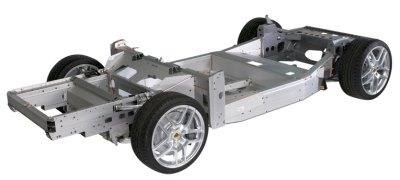
|
VVA chassis consists of a center tub,
and front and rear subframes, all made of aluminum.
|
These days Lotus no longer builds its own engines because it would cost
a hell lot of money. Therefore Evora employs a Toyota 2GR-FE 3.5-liter
VVT-i V6 together with a Japanese Aisin 6-speed manual gearbox. They
are mounted transversely between the rear wheels and contribute to a
911-like weight distribution of 39:61. You might notice that 2GR-FE is
exactly the same code as the one powering your modest Camry, and its
peak output of 280 horsepower is 40hp shy of a 3.4-liter Porsche Cayman
S, or 65 hp less than a 911 Carrera 3.6. Ironically, Toyota has a more
powerful direct-injection V6 in its parts pool, what a pity it is
designed for the rear-drive Lexus IS350 / GS350 instead of transversely
mounted applications, so Lotus had to compromise with the Camry engine.
Nevertheless, its own engineers did improve the engine a little. By
remapping its ECU, it is able to add a Sport mode which can lift its
red line from 6600 to 7000 rpm to satisfy the desire of keen drivers.
Throttle response is slightly improved by a lighter flywheel. Bespoke
exhaust system contributes to a sportier sound.
The
Evora tips the scale at 1382 kg, not much lighter than a 911 Carrera
3.6. This is quite disappointing by the standard of Lotus. Had it
employed a bespoke motor and transmission, it might have weighed less.
Lotus claims the Evora can do 0-60 mph in 4.9 seconds and reach a
terminal velocity at 162 mph. Frankly, in the post-GT-R era such
performance is no longer sparkling. There are many cars run
considerably faster in straight line yet costing less money to purchase
and run. In the UK, Evora starts at £50,000, marginally above the
dearest Cayman S. But it would be easy to option it up to
£60,000, right in the territory of the entry-level 911 Carrera.
It doesn't seem a bargain. Nevertheless, Lotus is still a reputed
marque, a name that usually appears in the same sentence as Porsche and
Ferrari. It should be a more sensible investment than the unknown
Artega, Farbio or Spyker etc.
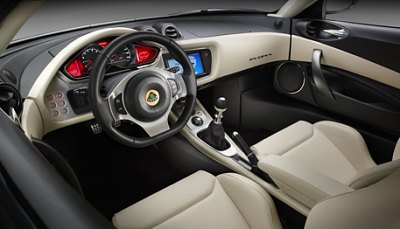
|
Although fit and finish still falls
short of the standard of Porsche, it at least shows that Lotus starts
taking interior quality seriously...
|
On the
Road
Open the doors, what a big difference to Elise ! First of all, it is
easier to get on board because the doors are larger, door sills are
lower and narrower and the seats are mounted some 65 mm higher than
those in Elise. You sit on the leather bucket seat rather than drop
into the tub. Once you are in place, you will notice how roomier this
place is. There is enough headroom for a driver up to 6ft 4in tall and,
unlike the case of Elise, he won’t rub his shoulder with the passenger.
The rear bench seat, as mentioned before, is suitable for young
children or luggage. This is the first truly usable Lotus since Excel.
However, even more surprising is the design and decoration of the cabin
– it looks quite elegant. The cabin is trimmed with quality leather to
draw your attention away from the black plastic background. The
instrument pod and center console are made of large pieces of real
alloy to remind you its expertise in aluminum technology. Its
cool-looking flat-bottomed steering wheel is even made of lightweight
magnesium alloy to reduce inertia so that you can feel every bit of
information from the road ! The instrument readings are chromed and
assisted by glowing LCDs. There are some nice bespoke buttons, knobs
and touch-sensitive switches. Although fit and finish still falls short
of the standard of Porsche, it at least shows that Lotus starts taking
interior quality seriously. Equipments are also richer than expected.
An Alpine multimedia system with a 7-inch touch screen LCD provides
audio, video, sat-nav and Bluetooth / iPod connectivity, something you
can’t imagine in previous Lotuses.
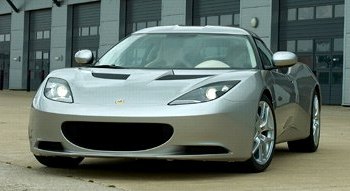
|
In silver it looks like a
shark...
|
Start the Toyota V6, it revs smoothly
while produces a subdued exhaust note. There is keener response than
the standard engine, but compared with a great motor like the
six-cylinder boxer of Porsche, it is almost too civilized and too
refined. There is plenty of torque from the mid-range to haul the car.
Its rev climbs linearly towards 4200 rpm, then the variable intake
system switches to short manifolds and its tone hardens. However, it
still lacks the aural drama of a proper sports car engine, which is
probably the biggest weakness of the Evora (as well as Elise, by the
way). On the positive side, you get a Camry-like fuel consumption of 33
mpg, better than either of its Porsche rivals.
The six-speed gearbox, which comes from the diesel Toyota Avensis,
shifts
surprisingly slick and accurate. This must thanks to the work done by
Lotus – the new gearshift linkage and a new clutch. On the highway, the
Evora feels brisk, if not as fast as its 0-60 mph figure suggested. It
won’t excel for performance, but it doesn't feel slow either. Just
adequate performance, I would say.
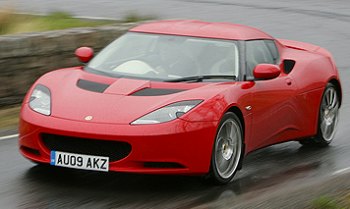
|
Even compared with Porsche Cayman S,
the Evora attacks the twisty in a much cleaner, tidier and calmer
fashion...
|
If
you are long-time fans of Lotus since the days of Colin Chapman, you
won't be surprised for its lack of firepower. History tells us a true
Lotus should amaze in handling rather than performance. Evora is the
same. Its chassis is nothing short of amazing - balanced, stable and
agile. Even compared with the very best Porsche Cayman S, the Evora
attacks the twisty in a much cleaner, tidier and calmer fashion. Its
suspensions soak up bumps and potholes on B-roads so well that you
never realize how bad the surfaces are. Switch to Cayman S and you will
find the car unsettled by the road irregularities that you have to ease
off the throttle. The Lotus is just that superior in covering long
distance in amazing pace with minimum fuss. Its smooth and quiet ride
has no reason to appear in a sports coupe. Lotus must have done a lot
of tuning work together with Bilstein to find out the best suspension
setup.
Other aspects of its handling are equally amazing. The
hydraulic-assisted steering is definitely the best of the class. It is
light and sensitive, offering uncorrupted feel from the front tires yet
having managed to filter out any unwanted kickback. The engaging feel
is further enhanced by a willing front end. Turn the steering wheel and
the nose immediately points to where you desire, thanks to the low
inertia up front. It possesses the same playfulness as Elise, just
being more refined simultaneously. In corners, the Evora is planted and
secured, displaying tremendous grip and traction - the rear-biased
weight pays off here. Even in rain, its inherent traction and balance
are so good that the electronic traction control rarely needs to
intervene. Its body control is exceptional, too. Hard cornering results
in nearly zero roll. Hard acceleration and deceleration cannot unsettle
its longitudinal stability either. The brakes are equally impressive in
power and pedal feel. Remember, they are larger than 911's yet doesn't
need to take care of as much weight.
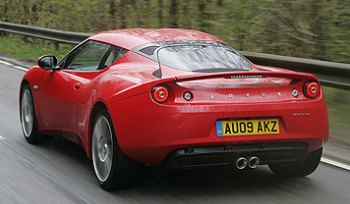 |
Lacking power and drama aside, this is
the best ever Lotus - and hopefully a big headache to Porsche
|
We
used to consider Porsche Cayman S a perfect sports car, so it is a
shock to find out that the new Lotus 2+2 beats it in ride and handling.
What Evora loses are two things: Power
and Drama. A stronger and
better-sounding engine could be an answer. Undoubtedly, the Evora we
see today is just the beginning. In the next few years, we shall see
derivatives with more powerful engines, most likely supercharged or
turbocharged ones.
So don't write off the British Motor Show yet. Stay tuned and wait for
more
exciting debuts in London. |
Verdict:      |
Published on 6
Nov 2010
|
All rights reserved.
|
|
Evora S
|
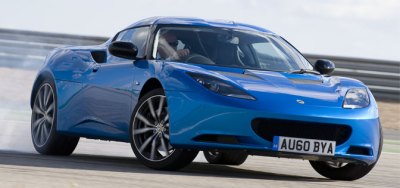
|
This might be the ultimate example of
classic Lotus - before the "Ferrarised" new models arrive...
|
Fabulous
steering, great
chassis balance, strong roadholding, supple ride, feelsome controls…
these factors help making Lotus Evora one of the best driver's cars in
the world. However, one problem keeps it from perfection: engine. The
Toyota 2GR-FE V6 might serves well in your workhorse Camry, but in a
thoroughbred sports car it is obviously short of power and drama. We
pointed out this problem in our original review. Now Lotus gives us an
answer: Evora S.
Evora S is basically a supercharged Evora. Undoubtedly, supercharging
is the easiest way to boost power. It doesn't need to modify
compression ratio, pistons or valves as in turbocharging. Just install
a self-cooling Eaton TVS supercharger to the Toyota V6 will do the job.
This is a roots type supercharger, but it features the latest 4-lobe
rotors (as in Corvette ZR1, Cadillac CTS-V and Audi's 3.0 TFSI engine)
to boost efficiency. Moreover, it does not hamper revability and sound
quality as in the case of older superchargers. In fact, it is even more
revvy than the old engine. Peak power is lifted by 70hp to 350hp, and
it is released at 7000 rpm instead of the previous 6400 rpm. Maximum
torque is improved from 258 to 295 pound-foot, accompanied with a wider
torque band. The official 0-60 mph time is shortened from 4.9 seconds
to 4.6 seconds, sounds not much, but one should remember that the old
figure has always been slightly optimistic, and the new figure is every
bit credible, if not conservative. Top speed is lifted by 10 mph to 172
mph.
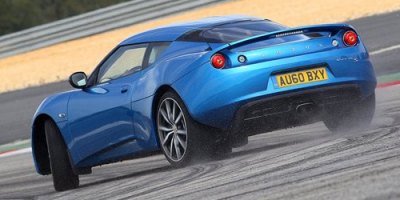
|
It finally gets the performance it
deserved, while still be able to improve on handling.
|
In the real world, the superior
mid-range torque, starting from 2000 rpm all the way to 6000 rpm, gives
the Evora S a much stronger performance than the standard Evora. It is
now in the same league of Porsche 911 Carrera instead of Cayman S.
Equally upbeat is the noise. A new exhaust (i.e. the only visible
change outside) generates a deeper tune, whereas the mild supercharger
whine actually adds to the character. Although the overall result is
still no match with a Porsche boxer, it is more lovely to ears than the
past.
Another revision worth praising is the gearchange. The 6-speed manual
gearbox itself remains the same, but Lotus has reworked its cable shift
mechanism and clutch. As a result, the gearchange has replaced its
rubbery feel with much higher precision and a cleaner, mechanical feel.
The clutch becomes lighter and easier to modulate. Another flaw of the
old car has been sorted out.
To cope with the increased performance and 55 kg weight increase, Lotus
has added cross-drilled disc brakes and retuned the suspensions -
stiffer bushings, slightly thicker rear anti-roll bar, revised dampers
(though the springs are unchanged) and tweaked suspension geometry.
This result in better roll resistance and high-speed stability. The
already superb steering becomes even sharper. Thankfully, the
wonderfully supple ride remains intact.
The Evora S costs £9,000 more than the naturally aspirated
version. This effectively put it in the same league of Porsche 911
Carrera. However, subjectively the gains it get are far more than the
price premium suggested. Even compare with the iconic German car, it
has an upper hand in dynamics and driver engagement. This might be the
ultimate example of classic Lotus - before the "Ferrarised" new models
directed by Dany Bahar arrive. |
Verdict:      |
Published
on 30
Jul 2015
|
All rights reserved.
|
|
Evora 400
|
|
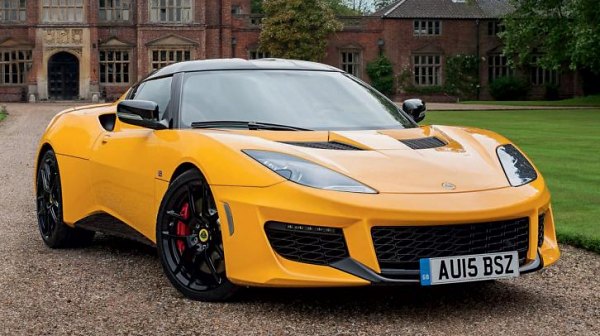 |
|
Priced
at £73,000, Evora 400 is now in the same ballpark as the base 911
Carrera...
|
|
Fate seems to be
unkind to Lotus. 5 years ago, we were excited with the superb ride and
handling of Evora S and were optimistic that it could finally give
Hethel the financial stability it deserved. That did not happen. Around
the
same time, its boss Dany Bahar launched a massive product offensive
which was set to promote Lotus to the league of Ferrari. Unfortunately,
before that plan materialize, parent company Proton was sold to
DRB-HiCom. The new owner sacked Bahar, scrapped the whole product plan
and installed Frenchman Jean-Marc Gales to look after its fragile
finance. Then came a series of cost cut and redundancy. Some Lotus
hardcores might be pleased to hear Gales declare the return to the
philosophy of Colin Chapman, chasing simplicity and lightness over
sophistication and luxury. In fact, without large investment that was
probably the only option he had. Lotus modified the existing Exige and
Elise, making them more track focused to avoid direct competition with
Porsche etc. To certain extent this strategy works. Gales succeeded to
bring sales back to 2000 cars last year, up from the previous low of
1300 cars. He increased the number of dealers worldwide and cut average
build time hence production cost. While Hethel is still making losses,
profit is finally
in sight.
To make profit possible, Evora 400 will be an important step. This
is easily the fastest and most expensive Evora yet. Priced at
£73,000 at its home market, it is £10K and £20K
dearer than Evora S and Evora respectively. In other words, it is now
in the same ballpark as
the base 911 Carrera, although traditionally Porsche drivers tend to
spend more on options. Is it really worth that much? Let’s see what you
get with that money…
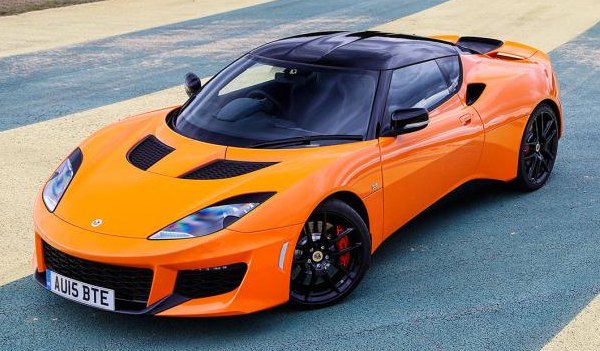 |
|
This
is the first ever Lotus to enter the 300 kph Club, although that top
speed sounds a little optimistic to me.
|
|
First of all, most obviously is a 400 horsepower engine. In fact, it is
rated at 406 hp in
our
usual DIN scale. The engine is still that
Toyota-based supercharged 3.5-liter V6, but a larger capacity
supercharger, more efficient charge cooler, larger bore exhaust and new
variable back-pressure muffler account for the additional 56
horsepower.
Peak torque increases slightly to 302 lbft, but it is now available
across a wider band, from 3500 to 6500 rpm instead of the previous 4500
rpm.
Lotus said the Evora 400 is good for 0-60 mph in 4.1 seconds, half a
second quicker than Evora S, while top speed is lifted from 172 to 186
mph. Yes, this is the first ever Lotus to enter the 300 kph Club! By
the way, the old Esprit never went over 175 mph.
That top speed sounds a little optimistic to me though, since the new
car has its drag coefficient increased from 0.33 to 0.35. The latest
design of Russell Carr, who also penned the old Evora, is noticeably
more aggressive, if less beautiful in my eyes. Obviously, it places
higher priorities to cooling and downforce through heavily modified
front and rear ends. Still, this is not exactly a downforce car like
Porsche 911 GT3 RS. Lotus said the downforce it produces at 150 mph has
been doubled from the old car, even so, the absolute value is only 32
kg.
The wider and grippier Michelin Pilot Super Sport rubbers also add
drag. They now measure 235/35ZR19 up front and 285/30ZR20 at the rear.
The new
forged alloy wheels are an inch larger yet they save
3.3 kg combined. BTW, the larger wheels look better as
they fill the wheel wells fuller.
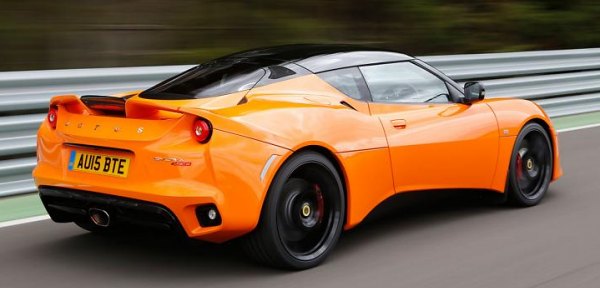 |
|
The
Evora 400 is 22 kg lighter yet gets a standard LSD and larger brakes.
|
|
Speaking of weight, the Evora 400 is 22 kilograms lighter than the old
Evora S. That is quite brilliant considering the new car gets a
standard Quaife LSD as well as larger brakes (370 mm front and 350 mm
rear instead of the previous 350 mm and 332 mm). Lotus had many
components re-evaluated to cut weight and cost. For example, the
revised
engine mount saves 5.6 kg, while the new Sparco bucket seats save 3 kg
each compared with the old Recaro items. They are cheaper to source,
too.
The suspension basics are unchanged but springs and dampers get
stiffer, as is the rear subframe which reduces engine
movement. The 2.8-turn hydraulic-assisted steering is carried over from
the old car, but it is mounted lower to reduce bump steer resulted from
the increased toe-in of front suspension.
However, the best news to many is perhaps the cabin. Lotus has
redesigned the aluminum tub for easier entry. Its sills are 43 mm
narrower and 56 mm lower, which is obvious from the interior picture.
Now the Lotus is no more difficult to enter than most Ferraris.
Brilliantly, its chassis rigidity is unchanged at 27,000 Nm
per degree. The cabin is also heavily redesigned with new dashboard
and door panels. The new HVAC is more effective. The Scottish leather
or
Alcantara trims look more expensive, although switches and infotainment
system remain too cheap to compare with Porsche's. For automatic
version – now simply called Automatic instead of IPS – you can finally
make gearchanges through aluminum paddles mounted behind the steering
wheel. BTW, Lotus claims the automatic option adds only 4 kg and
returns exactly the same performance. However, an automatic Lotus still
sounds nonsense to me.
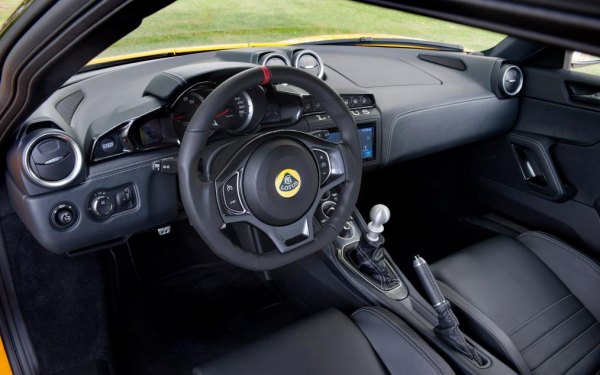 |
|
Redesigned
tub makes entry easier. Now it is no more difficult to enter than most
Ferraris.
|
|
How does it drive? Undoubtedly, the Evora 400 is a much faster car in
every respect. Its straight line performance matches a 911 Carrera S.
Its lap time at the Hethel test track is as much as 7 seconds quicker
than the Evora S, and ties with the much lighter, more hardcore Exige
S. While the supercharged V6 is not as charismatic as Porsche flat-6s,
it is strong and eager enough. Power is delivered linearly until the
7000 rpm
redline. Moreover, the new exhaust finally plays a sporty sound,
especially when
its flap is opened.
One drawback of mounting the powertrain transversely behind the driver
is a long and tricky gearshift linkage. Although Lotus said work has
been done to
improve shift quality, it still baulks occasionally, slowing down the
process and spoiling the fun you could have. If there is any dynamic
aspect significantly inferior to Porsche, this is it.
However, the Lotus always has a first class chassis. The Evora 400
keeps that superb balance and steering response while has its cornering
limits lifted to higher level. Those significantly wider rear tires
generate remarkable grip and traction. In combination with the LSD, it
allows you to accelerate out of corner much earlier and harder. The
stiffer suspension lessens body roll in corner. No, it’s not as
rock-steady as a Porsche Cayman GT4, but it rides considerably more
supple. Compared with the old Evora it does sacrifice some low-speed
ride comfort, but this is still one of the best riding sports cars you
can buy, especially at this performance level.
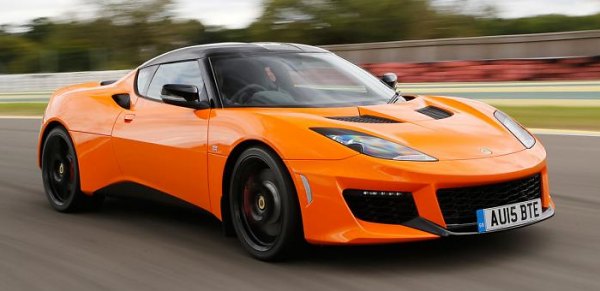 |
|
The
Evora 400 keeps that superb balance and steering response while has its
cornering limits lifted to higher level.
|
|
Likewise, the hydraulic steering becomes slightly less talkative,
probably due to the slightly wider front tires or the modifications to
reduce bump steer, but it is still one of the best steering available.
It is smooth, well-geared and it loads up beautifully in corners.
The Evora 400 turns into corner with the agility of smaller sports car,
but at the very limit it is never nervous. It understeers gently when
approaching the limit. You can counter the understeer by lifting off
throttle. Brake, re-apply throttle brutally and counter lock will push
it into a gentle oversteer or even a long power slide. Because its
mid-corner balance is so good and the steering is so faithful, you can
tweak its attitude with great confidence. The old Evora was also
renowned for balance, but the 400’s limited slip differential makes
things even better!
Yes, the new car is more capable and more fun to drive, so why doesn’t
it get 5-star rating? 5 years ago, the Evora S faced the old
Boxster/Cayman 987, which was neither so fast nor so rounded as today’s
981 series. Moreover, at that time there was no mid-engined Porsche
satisfying the desire of hardcore drivers as much as today’s Cayman
GT4. The latter might not have a chassis as good as the Evora 400, but
it has a better engine and a far superior gearbox. Its build quality
and features are way beyond the level of Lotus. In short, it is too
good for the Lotus to match. Lotus used to sweeten the deal with lower
prices, but the Evora 400 is no longer that bargain. Jean-Marc Gales
declared that no rivals at £73,000 offering comparable
performance. He might be right, because the £65,000 Cayman GT4 is
no longer on sale. A 911 Carrera is slower, but ask yourself, will you
choose the Lotus instead of a 911?
|
   
|
Published
on 8
Nov 2016
|
All rights reserved.
|
|
Evora Sport 410
|
|
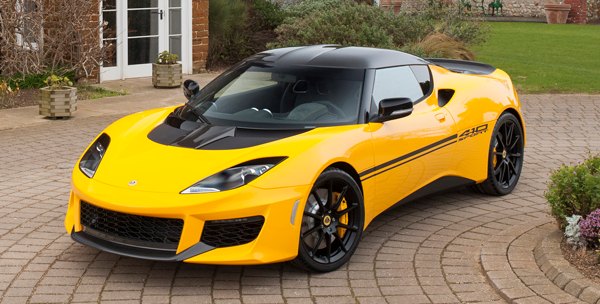 |
|
Sport
410 edges closer to the territory of 911GT3...
|
|
Every Lotus review
is a list of weight saving measures. The Evora Sport 410 is no
exception. This is the lightweight track-oriented version of Evora 400.
As its name suggested, power from the 3.5-liter supercharged V6 has
been boosted by merely 10 horsepower, which is purely ECU job thus it
is not the highlight of the changes. Instead, it is the weight saving
measures that count. The 410 gets rid of air-con and sat-nav to save 12
kg. Its cabin is very spartan, with bare door panels (-4 kg), thin
carbon-fiber bucket seats (-18 kg) and little sound insulation (-5.5
kg). The glass-fiber roof is converted to carbon-fiber (-2 kg). The
glass
tailgate is replaced with a one-piece carbon-fiber item with louvers,
which saves 12 kg, lowers center of gravity and simultaneously
makes the car look more aggressive. The rear quarter windows are also
replaced with carbon-fiber panels to cut weight. In addition to forged
alloy wheels (-7 kg) and optional titanium exhaust (-10 kg for a
considerable £5,500), the whole car tips the DIN scale at 1315
kg, a full 100 kg less than a standard Evora 400. It also undercuts a
911 GT3 by 115 kg, although the Porsche is quite a lot more powerful.
Yes, the new Evora edges closer and closer to the territory of the
mighty 911 GT3. With titanium exhaust equipped, it costs £87,500,
slightly more than a Carrera S, so it is no longer a British bargain.
In return, you get a similar level of speed and excitement to the GT3.
Officially, it is capable to top 190 mph and sprint from zero to sixty
in just under 4 seconds. On the Hethel track, it takes 3 seconds less
than the Evora 400 to do a lap. Even the track-oriented Exige Sport 350
is one second
adrift. In other words, it is Lotus’ fastest road car.
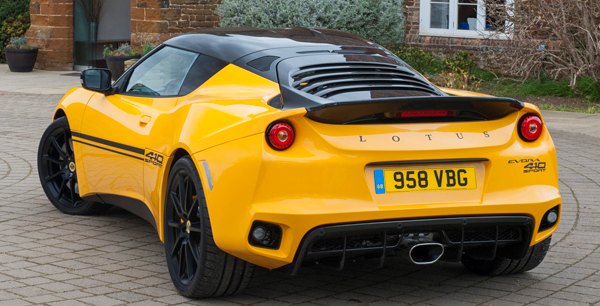 |
|
On
Hethel track, it takes 3 seconds less than the Evora 400 to do a lap.
Even the track-oriented Exige Sport 350 is one second adrift.
|
|
Part of the improved lap time comes from the use of Michelin Pilot
Sport Cup 2 tires whose sticky compounds produce superior grip. The
suspension modifications also help. While springs are unaltered, the
dampers get 25 percent stiffer rebound up front and 20 percent stiffer
compression at the back. The suspension geometry is tweaked slightly to
enhance
grip and stability in hard cornering. The ride height is dropped by 5
mm to help roadholding. The brakes are unchanged, but the reduced
weight means they effectively get more powerful.
Thanks to the drop of ride height, drag coefficient is lowered from
0.36 to 0.35. Meanwhile, the car produces double downforce at top
speed, up from 32 to 64 kg. This is contributed by the slightly
extended lip spoiler up front and the more pronounced boot lid spoiler.
On the road, the Sport 410 feels more hardcore than the 400. It lets a
lot of road and exhaust noise to enter the cabin. The ride is busier,
of course, but fortunately it is still capable to flow over B-roads
with a comfort many sporty road cars failed to match. Sharp bumps and
potholes fail to shake its composure. While Porsche 911 and 718 are
certainly better companions for long-distance journeys, the Lotus
excels on back roads, which is a surprising achievement for a
track-oriented machine. Another strength of the car is its hydraulic
steering, which is smooth and feelsome like no others. It reminds you
that the Lotus is one of the last analogue sports cars you can buy.
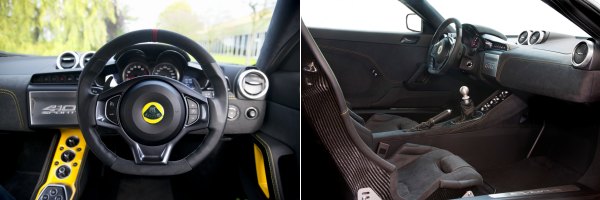 |
|
While
911 and 718 are better companions for long-distance journeys, the Lotus
excels on back roads.
|
|
On track, the superior grip and traction afforded by the Cup tires are
evident. However, the Evora hasn’t lost its sensitivity. If anything,
its improved front-end grip makes the turn-in even sharper. The
outstanding balance and throttle adjustability are intact. The brakes
are powerful and lets you corner incredibly hard. All the controls are
beautifully weighted, so the driving experience is remarkably engaging.
The barely tweaked powertrain is not in the same league as the chassis.
The titanium exhaust produces an angrier howl but ultimately the engine
note is not as characterful as a Porsche flat-six. While the
supercharged V6 produces satisfying amount of power and a linear
delivery, it is neither strong nor sweet-revving enough to be called as
world-class. The Sport 410 does feels fast. It might be the first Lotus
in recent memory to feel as fast as its manufacturer’s claims. That
said, it fails to worry the Porsche GT3 or even the Carrera S turbo. As
for gearbox, although the manual gearshift gets much more direct than
the original (pre-400) Evora, it is still not as good as Porsche’s.
As a daily transport, the Sport 410 is obviously inferior to Porsche,
too. Its spartan cockpit provides little creature comfort and
convenience. No, it is not meant to be an everyday car. As a
road-and-track dual-purpose car, it is eclipsed by Porsche GT3 in all
areas but steering and cost. However, this is still one of the most
engaging cars to drive in the world.
|
   
|
Published
on 19
Oct 2017
|
All rights reserved.
|
|
Evora GT430 and GT430 Sport
|
|
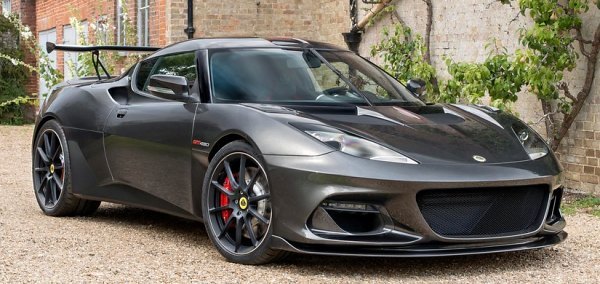
|
|
£112,500
Evora attempts to challenge 911 GT3. Is it good enough?
|
|
Lotus Evora gets more and
more powerful through the years, from the original's 280hp to 350hp
when a supercharger was added, then enhanced further to 406hp on Evora
400 and 416hp on Sport 410. It also gets more and more expensive in the
process. 8 years ago, the Evora started from just under £50,000.
Now the entry-level 400 asks for £74K, the Sport 410 £82K,
and the latest GT430 takes an even bigger jump to £112,500! That
is the same money as Porsche 911 GT3. Is it worth so much?
One deal-sweetening factor is limited production. Hethel is going to
build only 60 units of GT430, another 60 units of its tamer,
road-oriented version GT430 Sport and about the same quantity for a
batch to the US market. In contrast, Porsche builds thousands of GT3
each iteration, so the Lotus is significantly rarer. However, you might
say this has always been the case of Lotus vs Porsche. The fact that
Porsche can sell far more cars reflects that its cars are much
sought after. Nowadays sports car buyers are not stupid at all. They
are well informed about the car’s specifications, performance, handling
and build quality. Although more and more of them could afford very
expensive cars, you still need to convince them with solid facts and
figures, not just rarity.
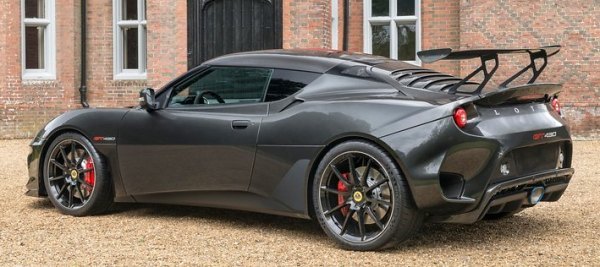
|
|
The
most expensive Lotus is also the fastest, though not the fastest in its
class...
|
|
Maybe performance can, because the most expensive Lotus is also the
fastest ever Lotus. It is good for 190 mph and 0-60 mph in 3.7 seconds.
It is capable to lap the Hethel circuit in 1:25.8, some 2.4 seconds
quicker than the Sport 410 and 0.7 second faster than Exige Sport 380.
Nevertheless, this time Lotus dare not claim it the fastest car in its
class, because the 911GT3 4.0 is obviously quicker at 198 mph and 0-60
in 3.3 seconds. Its power-to-weight ratio of 350hp per ton also topples
the Lotus’ 336hp per ton.
Compared with Sport 410, the supercharged V6 on the GT430 is tuned up
by 20 horsepower to 436hp (DIN) at 7000 rpm, while maximum torque is up
by 23 pound-foot to 325 lbft at 4500 rpm. Lotus doesn’t even mention
what have been modified, but it is known to be just a remapped ECU and
a baffled sump that withstands track abuse. The mighty titanium exhaust
is fitted as standard, which cuts 10kg while enables an angry
soundtrack. You can feel the extra grunt, but it does not change the
fact that the Toyota-based supercharged V6 is not in the same league as
the 9000-rpm naturally aspirated flat-six of Porsche. The latter is one
of the greatest engines the world has ever seen, while the Lotus power
unit is average at best in its class. Its power delivery is very
linear, throttle response is quick, but somehow the V6 lacks emotion.
Unlike the 500-horsepower Porsche, there is no tsunami level of power
and sound at the upper end. Nor its rev goes up and down as lightning
quick as the Porsche. The Porsche flat-six has a much wider power band
for you to stretch, and it is also more flexible, more responsive and
more musical. Likewise, the 6-speed manual gearbox on Lotus is
mediocre. It is carried over from the Evora 400, which got a
significant improvement from before but its cable-operated gearshift
remains occasionally obstructive. Such a powertrain combo might be okay
for a Cayman/Boxster rival, but at this price level it is just not good
enough.
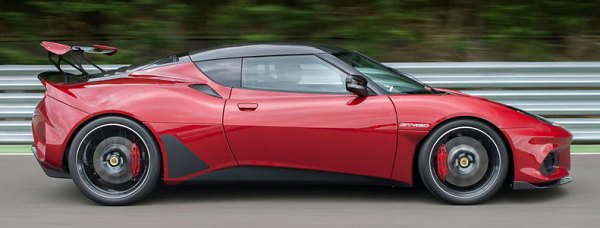
|
|
Its
power delivery is very linear, throttle response is quick, but somehow
the V6 lacks emotion.
|
|
Anyway, the Evora GT430 has a look probably deserving the high price. I
have never liked the 400 and 410's angular front end with rectangular
intakes, which do no justice to the otherwise sleek body shape.
Obviously, their outdated shapes were limited by the production
technique of glass-fiber. In contrast, the GT430 has sleeker, crisper
and more sculpted front and rear bumpers made of carbon-fiber. They are
undoubtedly expensive to source, which partly explains the elevated
price tag, but the supplier manages much higher build quality with
lower tolerances and a more complex shape than Lotus could do in-house
with glass-fiber. Apart from improving looks, the carbon bumpers save a
few kilograms from both ends thus reduce polar moment of inertia.
Carbon-fiber is also used to construct the car’s aero kits, including
the massive rear wing and front splitter, as well as the roof panel and
louvered tailgate. In addition to the standard titanium exhaust,
lithium battery, lighter Eibach springs, Ohlins dampers, forged alloy
wheels and AP aluminum-hub rear brake discs, the car is 26kg lighter
than the already lightweight Sport 410, lowering the kerb weight to
just under 1300 kg. Not quite as flyweight as Exige, but it is the
lightest Evora ever.
The front bumper incorporates channels that draw air towards the
outside of the wheels to form air curtains, reducing turbulence hence
drag. The larger diffusers, the huge rear wing and larger boot spoiler
contribute to 250 kg of downforce at top speed, a massive increase from
the 64kg of Sport 410. Most important, these racy aero kits make the
GT430 a far more serious looking machine. In addition to the black
triangular decor just ahead of the rear wheel arch (a tribute to the
classic 911 Turbo?), the GT430 looks really cool on the street. I
suspect many would be willing to open their wallets just for this look!
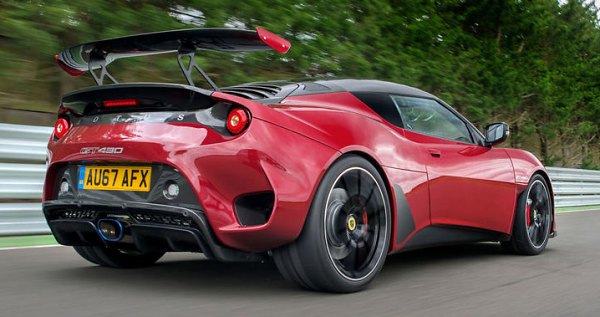
|
|
For
a 1300kg car, it is somewhat overtired, no wonder it generates
phenomenal grip on the dry.
|
|
Unquestionably, the car’s track performance is stronger than ever. With
Ohlins manually adjustable dampers and springs that are 47% stiffer up
front and 20% stiffer at the rear, the GT430 corners with precious
little roll and dive. Its footwork has switched to mighty Michelin
Pilot Sport Cup 2 rubbers with N0 spec like 911GT3 RS, and both front
and rear tires get 10mm wider to 245/35ZR19 and 295/30ZR20,
respectively. For a 1300kg car, it is somewhat overtired, no wonder it
generates phenomenal grip on the dry. In addition to the help of true
downforce, you can see why the car can be 2.4 seconds a lap quicker
than the Sport 410, which is already a respectable road and track car
in its own right. This is a very serious machine on the track. You can
push it incredibly hard in bends and lean on the powerful yet feelsome
brake.
The GT430 has a 5-stage traction control to supplement the Torsen LSD,
but even with it turned off you are still difficult to unstick its rear
end. It is not a powersliding machine like the GT3 or Speciale, not
only because it is so grippy but also its suspension setup is default
to slight understeer (though you can adjust the Ohlins dampers to alter
it). However, the car does feel light and agile. Turn-in is sharp, and
the hydraulically assisted steering transmits tactile road feel to your
hands. The inherent merits of Evora is kept largely intact, even though
the car now offers near supercar level of speed.
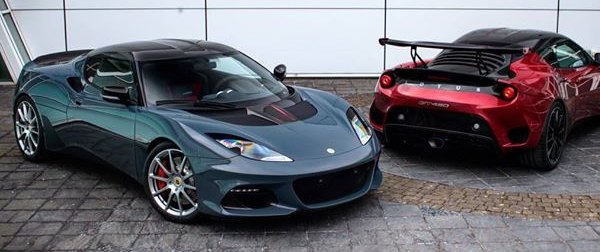
|
|
Confusingly,
Lotus calls the tamer version as "Sport".
|
|
That is how it feels on track. What about on a regular B-road?
Inevitably, the stiffer suspension makes the GT430 less supple than
lesser models, but since its baseline was so high, it still flows over
B-roads about as good as a 911GT3. On highway, the downforce leads to
excellent stability. On the flipside, the thinly insulated cockpit is
filled with a lot of tire roar and especially a loud exhaust roar at
speed. It is no longer a livable GT as the Evora originally aimed to
be. Moreover, the cockpit is spartan in standard form, as comfort
creatures like air-con and audio/sat-nav/touchscreen have all been
removed from the standard equipment list in pursuit of minimum kerb
weight. Rear visibility is nearly non-existent. 911GT3 is not only far
easier to live with, but it is a more rounded package and also the more
exciting car to drive when you are in mood.
GT430 Sport
Confusingly, the road-oriented version of the car is called GT430
Sport. It is virtually identical to the GT430 except reverting to
narrower tires and getting rid of aero kits, i.e. the front splitter
and massive rear wing. This means it not only looks purer (if not quite
as memorable) but also returns a lower drag. The latter lifts its top
speed to 196 mph. Inevitably, downforce is reduced to 100 kg at top
speed, thus the Sport is slower on track. The loss of aero kits save 10
kg and drops its price slightly to £105K, but without the
head-turning look, there are not many reasons to justify its very high
price.
One last point, both GT430s have pushed the Evora to the
extreme, far removed from its original performance and market
positioning. There seems to be not much room left for improvement, at
least
for cost-effective solutions. But traditionally a good Lotus model line
should last for over 2 decades. What will Lotus do to it with
fresh Geely money? I am interested to see.
|
Verdict:     |
|